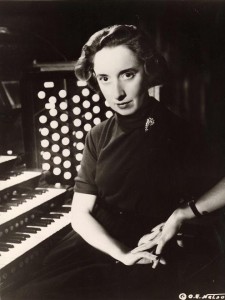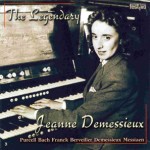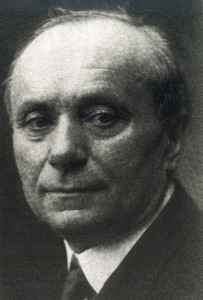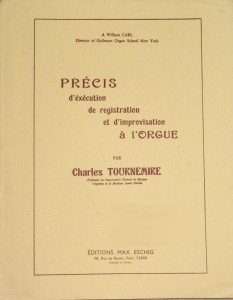 Jeanne Demessieux (1921-1968) began studying piano with her older sister, Yolande, before entering the Montpellier Conservatoire in 1928. In 1933, she entered the Paris Conservatoire, studying piano with Simon Riera and Magda Tagliaferro, harmony with Jean Gallon, counterpoint and fugue with Noël Gallon, and composition with Henri Büsser. She studied organ privately with Marcel Dupré before entering his organ and improvisation classes at the conservatory in 1939. After earning her first prizes, she continued private lessons until her concert debut at the Salle Pleyel in 1946. She served as organist at Saint-Esprit in the 12th arondissement from 1933 until her appointment as titular organist at La Madeleine in 1962. She taught organ at the Nancy Conservatoire (1950-1952) and the Conservatoire Royal in Liège (1952–68). She wrote over 30 compositions and made several recordings, including the complete works of César Franck.
Jeanne Demessieux (1921-1968) began studying piano with her older sister, Yolande, before entering the Montpellier Conservatoire in 1928. In 1933, she entered the Paris Conservatoire, studying piano with Simon Riera and Magda Tagliaferro, harmony with Jean Gallon, counterpoint and fugue with Noël Gallon, and composition with Henri Büsser. She studied organ privately with Marcel Dupré before entering his organ and improvisation classes at the conservatory in 1939. After earning her first prizes, she continued private lessons until her concert debut at the Salle Pleyel in 1946. She served as organist at Saint-Esprit in the 12th arondissement from 1933 until her appointment as titular organist at La Madeleine in 1962. She taught organ at the Nancy Conservatoire (1950-1952) and the Conservatoire Royal in Liège (1952–68). She wrote over 30 compositions and made several recordings, including the complete works of César Franck.
Recordings:

The Legendary Jeanne Demessieux: The Hamburg Organs
Festivo 6961862
Includes repertoire by Bach, Franck, Demessiuex, Messiaen and an improvisation on the choral “O grosser Gott der Treu”
Tag Archives: César Franck
Symphony
A symphony is a multi-movement form, usually tonal with the first movement in sonata allegro form. While originating as a suite of pieces for orchestra, as the tone palette of the organ grew, it migrated to a form for the newer romantic/symphonic organ. Though the very first organ symphony was written by German composer Wilhelm Valentin Volckmar in 1867, the genre is mainly associated with French romanticism. César Franck wrote what is considered to be the first French organ symphony in his Grand pièce symphonique, and the composers Charles-Marie Widor, who wrote ten organ symphonies, and his pupil Louis Vierne, who wrote six, continued to cultivate the genre. The Symphonie-Passion of Marcel Dupré is the reconstruction of an improvisation by Dupré that he made at Wanamaker’s in Philadelphia on 8 December 1921. While classical symphonies (and those written compositions) developed original material, it seems most improvised symphonies follow the pattern of Dupré in utilizing chants, chorales, or other themes known to the audience.
Videos:
Nigel Allcoat – Symphonie Improvisée on ‘Salve Regina’ – St Nicolas du Chardonnet, Paris
Jean-Baptiste Dupont – Symphonie improvisée playlist- St-Joseph, Bonn Beuel (Germany)
Noël Hazebroucq – Symphonie Improvisée 1: Allegro Sonate – La Madeleine, Paris
Noël Hazebroucq – Symphonie Improvisée 2: Scherzo – La Madeleine, Paris
Noël Hazebroucq – Symphonie Improvisée 3: Cantilène et toccata – La Madeleine, Paris
Otto Maria Krämer – Symphonie Francaise – Allegro ma non troppo
Otto Maria Krämer – Symphonie Francaise – Cantabile
Otto Maria Krämer – Symphonie Francaise – Scherzando on “Macht hoch die Tür”
Otto Maria Krämer – Symphonie Francaise – Prière
Otto Maria Krämer – Symphonie Francaise – Final
Charles Tournemire
 Charles Arnould Tournemire (1870 – 1939) was a French composer, organist, and accomplished improviser. His compositions include eight symphonies (one of them choral), four operas, twelve chamber works and eighteen piano solos. Today he is almost exclusively remembered for his organ music, especially L’Orgue Mystique, a set of 51 suites of pieces for the liturgical year based upon the chants of the day.
Charles Arnould Tournemire (1870 – 1939) was a French composer, organist, and accomplished improviser. His compositions include eight symphonies (one of them choral), four operas, twelve chamber works and eighteen piano solos. Today he is almost exclusively remembered for his organ music, especially L’Orgue Mystique, a set of 51 suites of pieces for the liturgical year based upon the chants of the day.
He studied organ with César Franck. From 1898 to 1939, Tournemire served as the organiste titulaire at Franck’s old church, the Basilique Ste-Clotilde in Paris. He was also professor of Chamber Music at the Paris Conservatoire. In 1931 he published a biography of Franck. A year before the biography appeared, Tournemire recorded five organ improvisations, which were later transcribed by Maurice Duruflé from the phonograph recordings. These recordings and most all of his improvisations were often rooted in the music of Gregorian chant.
Book:

In 1936, Éditions Max Eschig published Précis d’éxecution de registration et d’improvisation à l’orgue by Charles Tournemire. Of the 117 pages, only the last 16 are devoted explicitly to the art of improvisation. Much of the text is devoted to philosophy, references to examples in repertoire, with some explanation of forms. Tournemire writes that the most profitable study that one could do is to read each day a sonata of Haydn, Mozart or Beethoven, and then to take the same elements and try to develop them oneself.
Recording:
Charles Tournemire: Complete Recordings
Videos:
*original audio recorded by Tournemire with slide show of pictures for videos
Charles Tournemire – Te Deum – Ste. Clotilde, Paris, France
Charles Tournemire – Fantasie on ‘Ave Maris Stella’ – Ste. Clotilde, Paris, France
I couldn’t find a video or audio online of Tournemire himself playing the other improvisations, but am including performances by other organists below because these have been such influential and well-known improvisations:
Charles Tournemire (Philippe Lefebvre plays) – Victimae paschali laudes – Chartres Cathedral, France

